It was the summer of 2016, a few months before launching Mezcal Reviews. Jonny and I met after work at The Austin Shaker, a local bottle shop, to browse their mezcal selection. This was part of our “research phase” before launching the website. We chatted a bit with Kiki, the co-owner, who was eager to assist with our growing interest in mezcal. She reached up to the top of the mezcal shelf and pulled down a bottle with a simple blue band label. This was a pechuga from a brand called Mezcal Tosba and there were only a few bottles in Texas. We had never heard of Mezcal Tosba but were fascinated by the limited quantity.
We arrived back at my place in the early evening to try our new purchases. Jonny had the Tosba and I had gotten a bottle of Wahaka Madre-Cuishe. At that time, these were the most expensive bottles of mezcal we had ever bought! A lot has changed since then. We cracked open the Tosba Pechuga and poured some into our OG drinking vessels – Del Maguey copitas. Aromas of fruits and nuts rose from the clay cups. Initially, we both found it a bit strong on the palate, but we enjoyed the complex flavors of meat and chocolate. As time went on, it became one of our favorite pechuga mezcals… more on that later.
In 2004, NPR reporter Marianne McCune did a story for All Things Considered about mezcal. The town of Zoochila in Oaxaca had a problem, half of their residents had moved to California. The money sent from the United States helped the community buy cars and build better homes. The funds helped children in the town pay for advanced education. But families were torn apart by the distance. Kids grew up without fathers. In Mexico, small villages like Zoochila are run by local volunteers. When too many residents leave a town and the leadership positions cannot be filled, it threatens the local infrastructure.
View this post on Instagram
Instagram post #6 (August 2016)
The volunteer treasurer of Zoochila hatched an idea to create local jobs; they gathered to form a mezcal collective. Their goal was to produce mezcal in Zoochila and eventually sell it outside of Mexico. These producers were passionate about creating a quality product. After all, their mezcal was a representation of their village. They criticized producers that used fertilizer to hurry fermentation time to 24 hours. Their mezcal took around 8 days to ferment and it tasted better. Unfortunately, the group hit a roadblock. Their application for mezcal certification was denied. The 2004 NPR radio segment ends on a “time will tell” pessimistic note.
> Listen to the ‘All Things Considered’ segment from 2004
In 2013, Elisandro Gonzalez contacted Marianne, the NPR reporter, about Mezcal Tosba. Elisandro and his cousin Edgar González Ramírez grew up in San Cristóbal Lachirioag, a few towns over from Zoochila. Elisandro’s story was like her 2004 story, but with a twist. Mezcal Tosba was about to launch in the United States. Marianne decided to meet Elisandro for thematic sequel to her 2004 story. Together, they visited a few bars around San Francisco to showcase Mezcal Tosba Espadin. In the audio clip, a bar owner described the Espadin: “Its got those perfume qualities in a much earthier and muskier sense.”
If you listen to both of these stories, they share a similar first act. Like Zoochila, many residents from San Cristóbal Lachirioag had migrated to the US in search of jobs. Edgar and Elisandro both worked very hard when they were young to get into the best schools. Both young men knew they wanted to give back to their community but they didn’t know how at the time. In school, Edgar studied computer science. He was the pride of his family and the first to graduate from college. Yet, much to their disappointment, he decided to migrate to Northern California. He worked as a cook, roofer, and also worked nights at a Subway sandwich shop.
A Walk in the Clouds
During some downtime, Edgar watched the film A Walk in the Clouds which is set in California wine country. The lead character, played by Keanu Reeves, ends up on the vineyard while helping a young woman. He doesn’t intend to stay long, but he falls in love with her and her family’s way of life. Edgar admits it is cheesy, but the portrayal of life on the vineyard inspired him. “I want to live like that!”, he says in the radio segment. Back in San Cristóbal, instead of grapes he could grow agave.
The journalist narrating the radio segment reminds us that Edgar did not have any experience producing mezcal. Nonetheless, Edgar became obsessed with his vision. He began spending his free time in California wine country and absorbing the knowledge around him. The money he sent back home went towards planting agaves. When he visited Oaxaca, his friends asked him, “Where is your car? Why don’t you have a new house?” Nearly everyone, including his family, thought Edgar was loco.
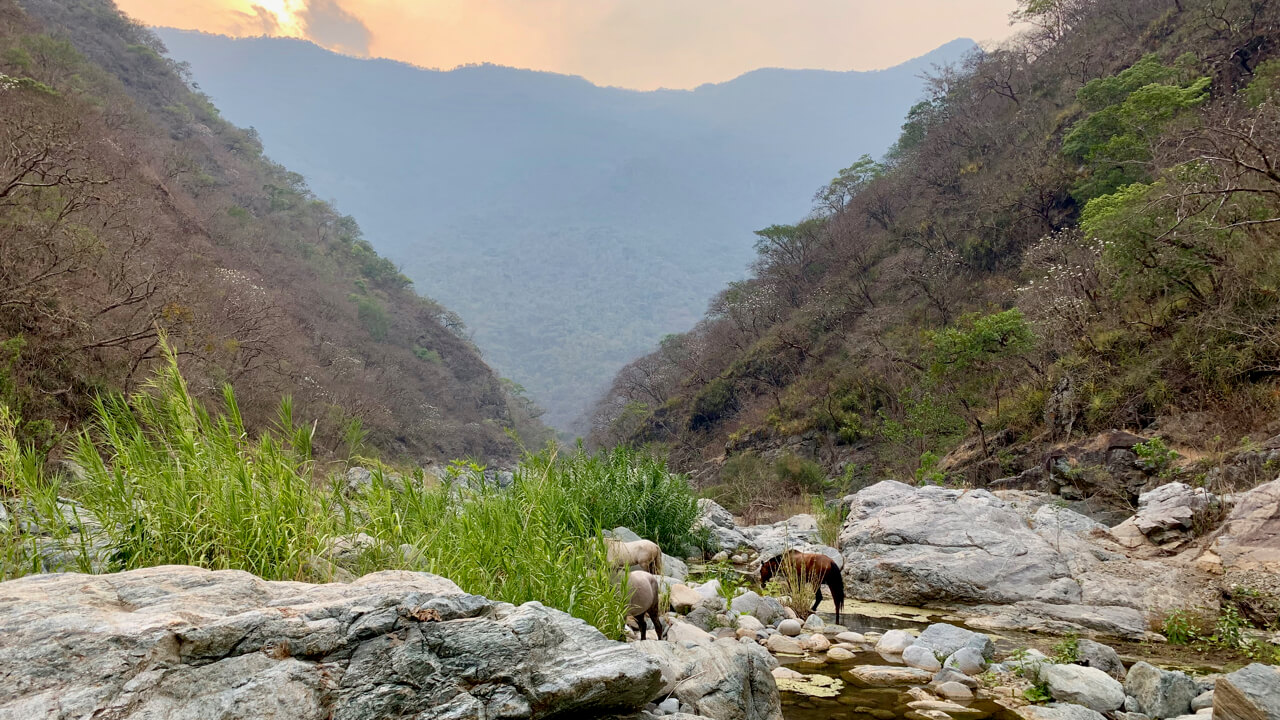
The river valley in San Cristóbal Lachirioag, Oaxaca
At this point, Edgar was the only crazy one. He needed someone else to share his dream. His younger cousin, Elisandro, moved to California after high school. Like Edgar, Eli worked many jobs: busboy, waiter, and bartender. In San Jose, they were roommates. One night while drinking wine together, Edgar shared his dream of making mezcal in San Cristóbal. They could move back home. The brand would provide jobs for their community. They could export it to the US themselves, without middlemen. With zero hesitation, Elisandro was in… and like that, their journey began.
If the pair were going to launch a mezcal brand, they needed to learn how to make mezcal and to sell mezcal. So Eli went back to Mexico to attend college and study international business. Edgar went back to San Cristóbal to build a palenque and learn how to make mezcal. The palenque was completed in 2008 but it would be years before they exported their first bottle. Edgar distilled mezcal for an entire year and deemed none of it worthy for export. He set a high standard for himself and the Mezcal Tosba brand.
In 2014, the NPR journalist visited the palenque to witness their first bottling. There was a 2,000 bottle batch of Tosba Espadin slated for export to the United States. It was a very happy moment for Edgar and Elisandro after many years of work. But there was more work to be done. They had created a few temporary jobs, but they also had a backlog of startup expenses. Edgar and Elisandro had also not yet paid themselves at this point. They planned to increase production and distill different types of agave. They also wanted to collaborate with nearby mezcaleros, like the ones from Zoochila. By the end of the radio episode, Elisandro was still working as a bartender. After two months, they had sold 1,500 bottles, two-thirds of their initial batch. This time, the report ends on a note of cautious optimism.
> Listen to the ‘Planet Money’ segment from 2014
We launched Mezcal Reviews in the fall of 2016. Shortly after, we added the Mezcal Tosba lineup (at that time): Espadin, Pechuga, and Tobala. While researching content for the website, we discovered the aforementioned 2014 NPR story. The Planet Money episode “Can Mezcal Save A Village?”, transported us to Oaxaca. Two cousins from a small mountainside community in Oaxaca created a mezcal brand 10 years before exporting a single bottle… how crazy is that?
More than mezcal
Fast forward to July 2017, we published a book review for The Mezcal Rush by Granville Greene, here is a snippet:
Later, [the author] meets the founders of Mezcal Tosba who worked restaurant jobs in California and sent money back home to their village so agaves could be planted. The business models developed by these two brands (explored in this book) represent a bright future for mezcal.
Little by little, we were learning more about Mezcal Tosba, but their mezcal remained a bit of a mystery… especially for us in Texas. How did their mezcals compare to mezcals crafted by 4th generation mezcaleros? While on work trips in San Francisco, I would see Mezcal Tosba Espadin on the back bar and order a pour. Then their exquisite Tosba Tepeztate mezcal landed in a few states. At Mexico in a Bottle in New York City, their exclusive agave Warash mezcal debuted. We learned about the Warash through social media. Brand owners and attendees showed off their bottles of the limited Warash on Instagram. Agave Warash is a species endemic to the Sierra Norte region of Oaxaca, Mexico. The agave is currently not classified by the Consejo Regulador del Mezcal (CRM). Mezcal Tosba is the first brand known to distill and export agave Warash mezcal. For mezcal explorers like us, Warash represented uncharted territory.
We scoured the internet in search of a bottle of our own… and came up empty. Months passed and it was clear we would have to leave Texas to try this rare elixir. During a long rainy layover in New York City, I convinced my girlfriend to make a detour to Madre Mezcaleria. While other patrons nibbled on their brunch plates, we sipped Mezcal Tosba Warash. It tasted completely new and utterly unique. It was like a fruity agave Americana with notes of grilled pineapple. Our detour to Brooklyn was worth it. As we left the city I wondered.. what was next for Mezcal Tosba?
Visiting Mezcal Tosba
Through a series of fortunate events, we had the pleasure of visiting Mezcal Tosba in May 2019. The day before heading out to the Sierra Norte, our crew of four met up with Elisandro. He took us to a bar that was full of locals on Labor Day, May 1st. There was a Champions League game on all the TVs: Barcelona vs. Liverpool. We stood near the bar eating chips and sipping on Coronas. Messi scored ridiculous penalty kick and the bar erupted. I’d told Jonny and our other amigos the drive to Tosba takes around 5 hours. We needed to leave before dawn. Elisandro offered up a few start times, 5am, 6am, 7am… I was eager to get out there but the consensus was 7am and that was for the best.
The drive from Oaxaca City to San Cristóbal Lachirioag is long, winding, and steep. Elisandro told us the drive used to take well over 6 hours before the current road existed. A future road will cut the journey to around 3 hours. During our drive we got to know Eli better. He is extremely generous, polite, and intelligent. Elisandro had a connection to nearly everyone in the world of mezcal. In an industry full of gossip, it seemed that Elisandro was immune to it all. A special force-field of good vibes surrounded Mezcal Tosba. We felt it the first time we tried the pechuga years ago. And now we drove towards the birthplace of Mezcal Tosba.
As we zipped through the mountains we learned more about the beginnings of Tosba. The word “Tosba” is Zapotec for “just one” in the context of inviting a friend to hang out. The word itself is a bit tongue-in-cheek because who really stays for “just one”… especially if it involves mezcal?
When Edgar was first building the palenque there wasn’t a road from the village. At the time, he didn’t have a car either. Every day, he walked over an hour each way from the village on the mountainside to the palenque in the valley below. The land was dense with trees and it took years to clear. Even after a road was built, it often washes out during the rainy season and needs to be dug out again. In 2009, the village’s outdoor market was moving and Edgar managed to get its large metal roof for the palenque. Later, he added a solar panel to power LED lights after dark.
Arriving in San Cristóbal Lachirioag
“We’re close”, said Elisandro, steering his Honda Element off the main road onto a red dirt road. We were on the side of a mountain with a green valley in front of us and mountains as far as we could see. “These are our agaves, wanna check them out?”, asked Eli. We got out and walked down to a hillside full of agaves. The plants were perfectly positioned in the sunlight like satellites. Elisandro pointed out the various agaves, mostly Espadin and Tobala. Eli told us that many people have firm rules about mezcal and agaves. “Everyone says Tobala takes over ten years, these are ready in about six.” For example, Del Maguey describes their 12-18 year agave Tobala plants as “… found growing naturally only in the highest altitude canyons in the shade of oak trees like truffles“. The Tobalas that we observed had maximum exposure to sunlight. This likely contributed to their rapid growth, shorter lifespan, and larger size. There are different subspecies of agave Tobala as well which could be a factor.
We got back in the SUV and descended into the jungle valley. We could see the large palenque roof in a sea of green trees. The dirt road was steep. There was one part in particular where I wondered how the vehicle would make it back up. We drove past more agaves and soon arrived at the palenque. Parking next to a clean white truck with a Tosba decal on the door, we got out. The rainy season had not yet begun, but this part of Oaxaca was quite lush. It felt a world away from Oaxaca City and the Valles Centrales.
Our group got out of the vehicle and stretched our legs while looking at the palenque. Smoke was coming from the nearby stills. It was time to meet Edgar. He wore a baseball cap and a t-shirt with an American flag on the front. His demeanor was soft yet deliberate. He reminded me of Marlon Brando in The Godfather; when he spoke, everyone listened. Edgar would explain something in a very serious manner but then crack a smile. His English was better than our Spanish and he was eager to show us around. The palenque was like a badass vacation home in the jungle. There were beds, a kitchen, and a large entertaining area. Edgar stays at the palenque most nights while his family lives in the village closer to his boys’ school. The family visits often and helps run the palenque too. Edgar showed us a cell phone video of his sons loading the underground oven with agaves.
Ancient traditions and modern techniques
As of this writing, the Tosba palenque has two hornos (underground ovens). One is larger for batches of agave Espadin or Tobala while the other is smaller for more rare agaves. The team had a shredder to grind the cooked agave but Edgar didn’t like it. Now they use a horse-drawn tahona (stone wheel). They have three horses that take shifts pulling the tahona. When not “crushing it”, the horses roam free around the valley and drink from the nearby river. The agave fibers and spring water ferment in open-air for one day. After a day, the wooden vats are covered for the rest of the fermentation. This is done to keep any smoke from the nearby wood-fired stills from affecting the flavor. It also helps keep the fermentation temperature consistent. There are four copper stills; two of them have stainless steel condensers (see photo). Edgar noticed a copper taste in his mezcals that he didn’t like. Now, the second distillations happen only in the stills with the steel condensers.
Before going for a hike, we took a break to taste some mezcal. Edgar stood behind the palenque “bar” which is a recycled alter that a church had given away. He lined up some vaso veladoras and said, “now we make a different kind of blessing.” We all laughed. Edgar is university educated, but he is a self-taught mezcalero and proud of it. When he was learning to make pechuga mezcal, he kind of assumed all producers made them in a similar way. He learned the method of putting all the ingredients into a pouch and hanging it in the still (above the liquid). Edgar also did this during the second distillation. He learned later that many producers hang the meat but put the other ingredients into the mezcal. Additionally, it is common for the extra ingredients to be in the third distillation. As we sipped some of Edgar’s most recent batch of pechuga, Edgar cracks a smile. “This is good so I don’t need to change it… plus the yield is better,” he said. We agreed!
After a few mezcals, we hiked with Elisandro down to the river at the bottom of the hill. It was sticky hot that afternoon and a swim sounded perfect. Eli led us down the trail and we arrived at a small waterfall. The source of the spring water was higher up the mountain. Closer to the palenque, there was an outlet where the team captures water for the fermentation vats. Standing below the rushing water, Elisandro told us, “Try some, it tastes like Tosba.” He and Jonny scooped their hands to try some. The rest of us held back… committed to our water safety instincts. We’ll stick to the mezcal version.
Further down the hill, we reached the river. The water was refreshing and moved fast. The Tosba horses grazed and drank water nearby. Edgar likes to fish on the river after a rain, when the fish are feeding on the runoff. The river also brings driftwood which they dry out and use to fire the stills. “We have everything we need here,” Edgar said, when we arrived back at the palenque. Once a resident of Silicon Valley, Edgar now thrives in the nature of the Oaxacan Sierra Norte. He learned to harvest agave based on the schedule of the moon. This ‘lunar farming’ technique is not new, but we have never heard it discussed in regards to agave harvesting. It is common practice to avoid agave harvesting during the rainy season, but this was another level of sophistication. During a full moon, the tides are high and the moon pulls water towards the surface of the earth. This is a great time to harvest fruit but not agave. The entire process becomes more difficult if there is too much water in the plants. Additionally, the sugar content is lower and it affects the production yield.
Investing in agave
The Mezcal Tosba nursery was behind a fence so the horses would not eat the baby agaves. A large net enclosed a tennis court sized area. But, Elisandro told us that the baby agaves grown inside the netting didn’t fair as well the ones outside. So, they grow most of the baby agaves outside the net. Once they have a few leaves, they replant the little agaves on the hillsides around the valley. Eli told us they had planted 16,000 Tobala agave plants in the last year! I asked him to repeat that incredible number in case I had misheard it. Elisandro was casual and humble about it, and I began to doubt my numerical reasoning. Besides agave there were fruit trees, coffee plants, and sugarcane growing around the palenque. We were excited to try the coffee the next morning.
After the nursery, we walked through the young agave field in front of the palenque. These were experimental grounds featuring many different types of agaves. Years from now it will be a diverse “front lawn”, greeting visitors on arrival. Now, the plants were tiny and some were struggling. Agave Karwinskiis are not native to the region, but they had planted many of them. We walked through the field with care, stepping over young agaves. Then we headed into the jungle to see some agave Warash. After five or ten minutes of hiking we came to a clearing in the jungle. Elisandro pointed out a large agave Warash. The stalk of the agave was like an agave Karwinskii type stalk and the pencas (leaves) were like those of an agave Mexicano. It was special to see this unclassified species in nature. Many of the Warash plants were reaching maturity. Eli said there would be another batch of Warash coming soon. We asked him to send some to Texas when it was ready.
The sun was setting and we wanted to see more agaves before it was dark. Jaguars were native to these mountains and had better night-vision than we did. Back at the palenque, we crossed the road and then went back into the trees on the other side. A flat trail twisted around large Espadin agaves. The sharp tips on some of the pencas were pruned to prevent accidental pokes. We walked through some trees and emerged on an open hillside filled with gigantic Espadin agaves. “It must be very difficult to harvest the agaves where it is steep like this?”, I asked. I was imagining giant piñas rolling down the hillside like the boulder in Indiana Jones. Elisandro told us that everyone was used to it. Living and working on the steep hillsides was part of life here. They didn’t have hiking boots either. Edgar, Eli, and the locals all wore these badass leather sandals (huaraches) made in the next town over. And they did in fact, let the agaves roll down the slope towards the palenque. This was by design and made it easier for the team to transport them.
Dakabend aguardiente de caña
Back at the palenque, the sun had fallen and the bugs were starting to get us gringos. Friends from town were visiting and Edgar was holding court behind the altar bar. “What do you want to try?”, Edgar asked us. “Can I try the aguardiente?” We had heard that Edgar had distilled sugar cane and was about to export it the United States. Before Tosba, mezcal distillation had not existed in San Cristobal for many generations. But sugarcane had always been abundant and aguardiente production was common. Edgar’s father had even produced aguardiente at certain times in his life.
A week before our visit, a Reddit post revealed that they had exported a batch under the El Destilado label (a brand from the UK). A few weeks after our visit to Tosba, that aguardiente de caña bottling won Best Rum at Cocktails Spirits in Paris. The story we heard was this: Edgar had distilled the batch a few years earlier. He had held onto it because he didn’t think it was good enough to send to the US. After some back and forth, he agreed to sell it for export under the other label. Then it arrived in Europe and won a major award. The irony of the situation was poetic.
Back at the palenque, Elisandro took out his phone to show us their label for the aguardiente. Their new brand is called Dakabend. The word means “the disobedient one.” Dakabend is someone that follows through with their ideas despite being discouraged. Edgar and Elisandro built Mezcal Tosba over many years without much to show for it. Back then, their family called them Da Ka Bend. Now, these “unruly cousins” are entering a new chapter of success with the upcoming launch of Dakabend: Pot Still Rum from the villages of the Sierra Norte.
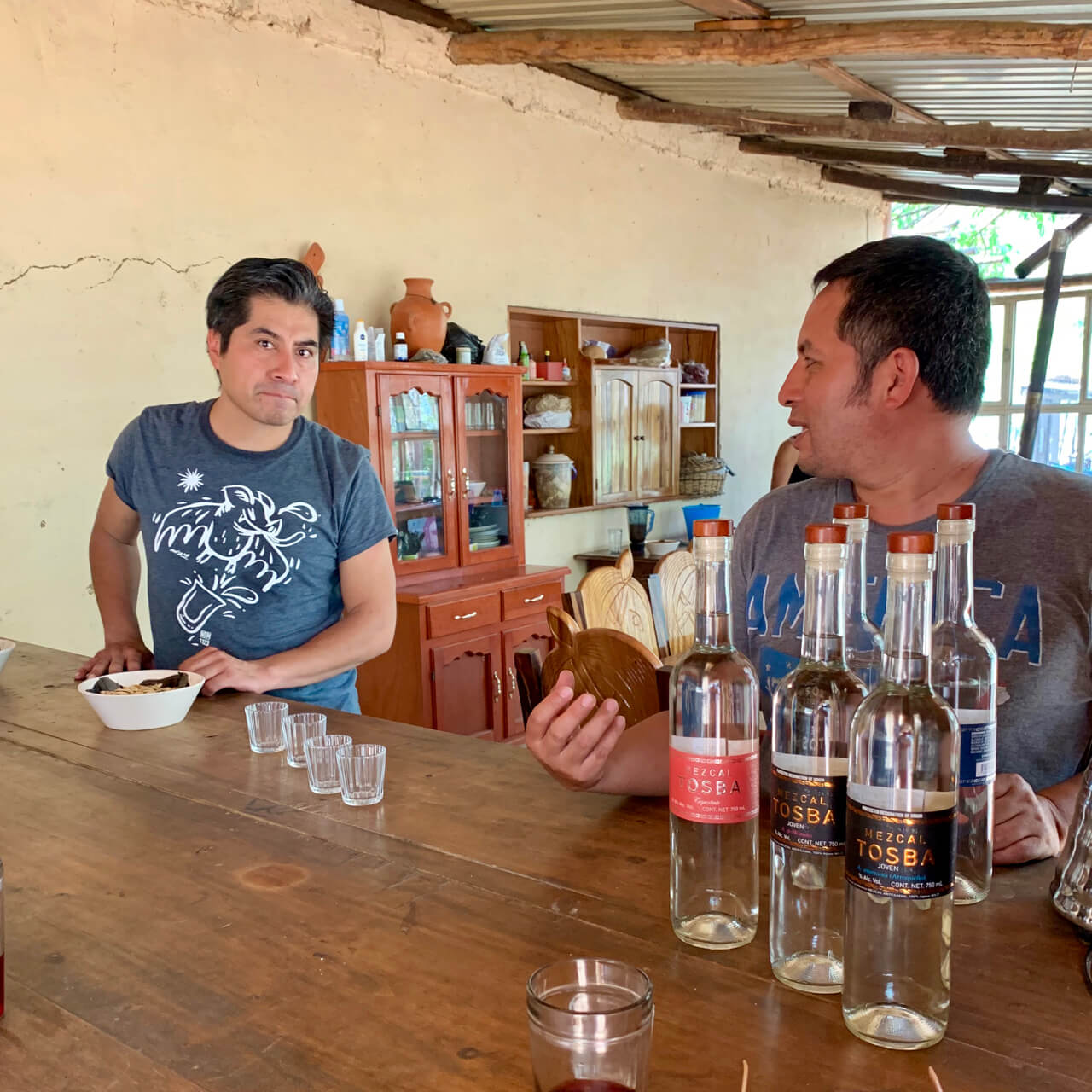
Elisandro and Edgar sharing stories behind the bar
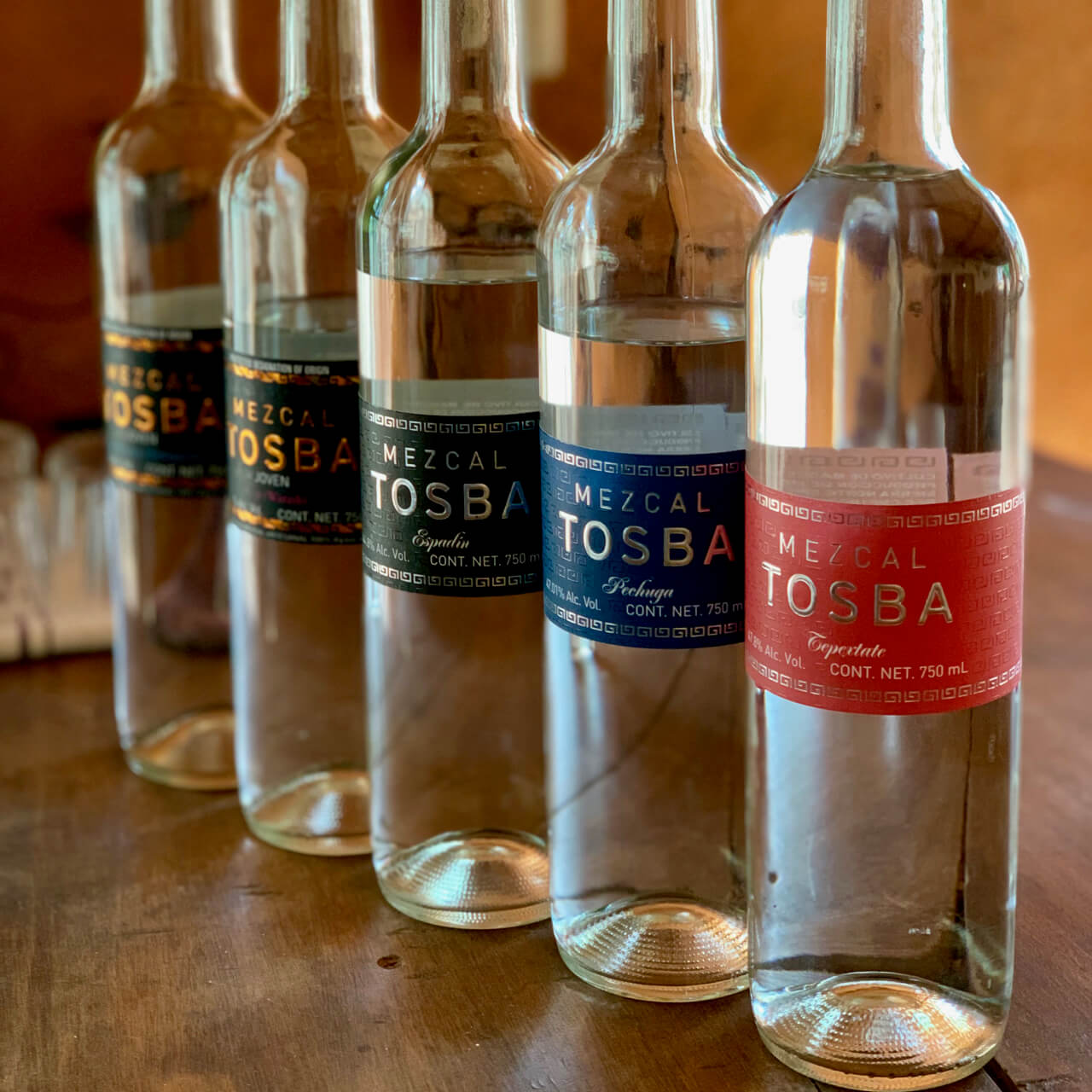
The current Mezcal Tosba lineup (sans Tobala)
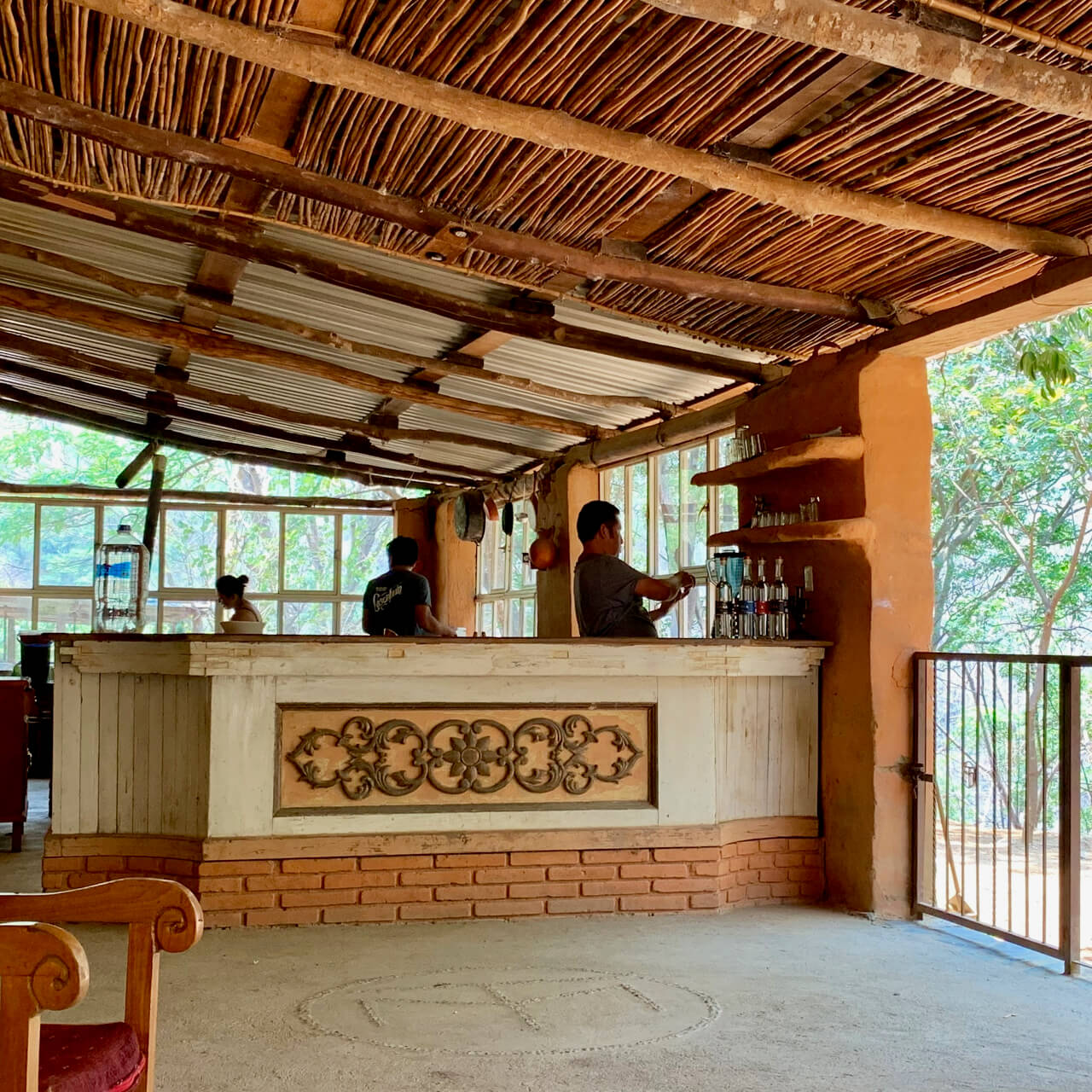
The “altar” at the Mezcal Tosba palenque
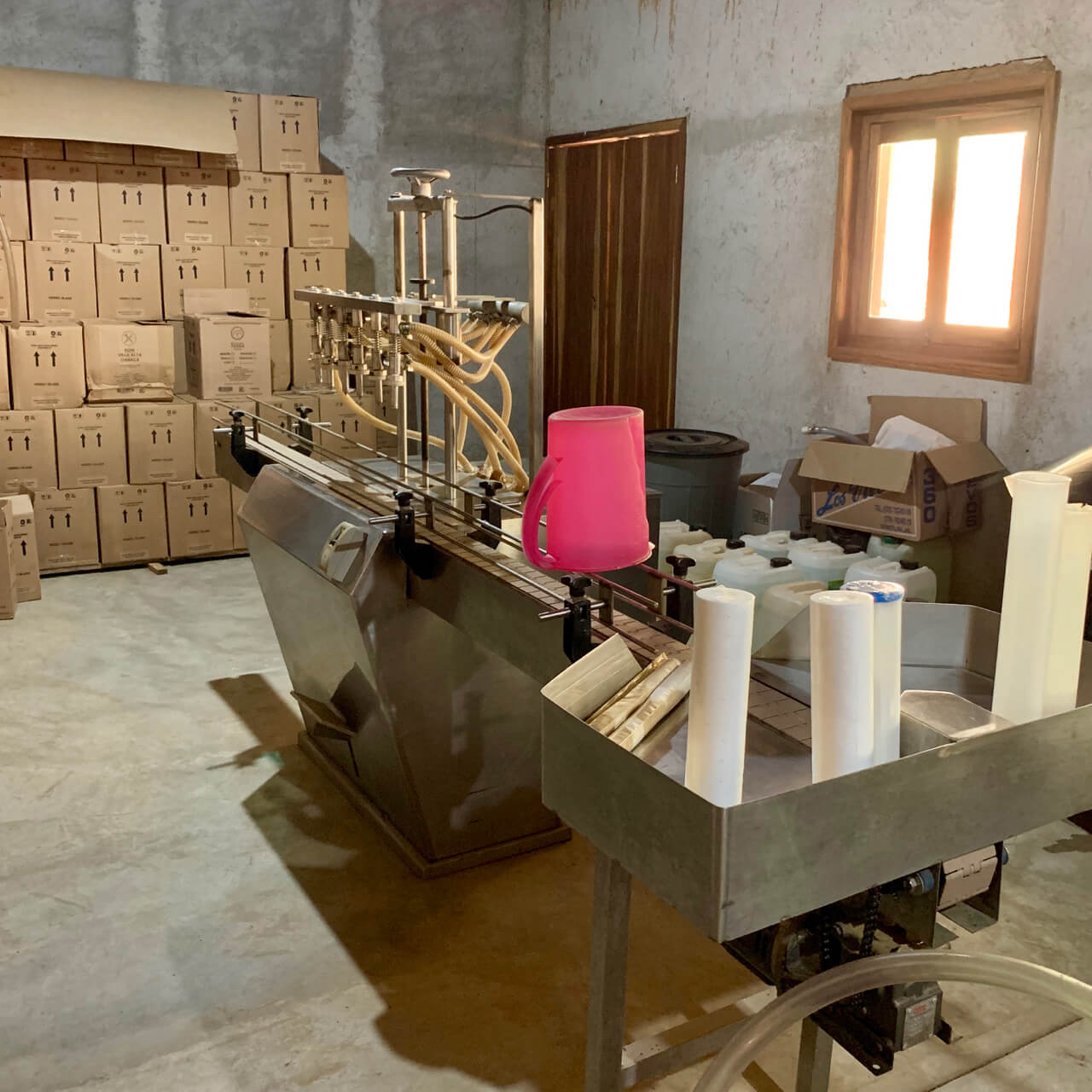
Bottling is done onsite to provide work for the community
“I can distill anything, if it has sugar I can do it,” Edgar told us as we tasted the aguardiente. He is confident, but also conservative. He had been distilling aguardiente for a few years but only recently shared it with the world. Its flavor is organic, earthy, and complex. He tells us the yield is incredible compared to agave. Mezcal is more popular every year, but rum is a mainstay in bars around the world. The price point is also perfect for cocktails which means volume. Mezcal Tosba Espadin worked in cocktails in the early days with it’s low price and 42% ABV. Newer batches are “still-proof” and adjusted with puntas and colas. According to Elisandro, it was too difficult to get the alcohol to 42% for each batch. Plus, we all agreed the taste is better at a higher proof. With the rum and the mezcal, they have an impressive portfolio.
Elisandro said we were lucky they had so much mezcal at the palenque. Sometimes they only have the Espadin or no mezcal at all when visitors arrive. We tasted the Espadin, Pechuga, Tepeztate, Warash, and Arroqueno. Mezcal Tosba has an agave Tobala mezcal but there was none at the palenque that week. Their delicious batch of Arroqueño was so small they decided not to export it. Edgar’s wife was fine with that, it was her favorite. We all noticed the aroma of Skittles when we had our first sip. Edgar was excited to make another batch of Arroqueño. Most of the agaves in their mezcals are grown nearby. But the team likes to experiment and they buy agaves too. They purchased agave Tepeztate from the Valles Centrales for their incredible Tepeztate releases. It was hard to choose a favorite, but there was universal love for the Warash.
Dia de la Santa Cruz
The next morning we enjoyed some palenque coffee and packed up. Before heading back to Oaxaca City, we went into San Cristóbal. It was Dia de la Santa Cruz and we joined Eli, Edgar, and Edgar’s wife on the ride up the steep hill from the palenque. We stopped to view the largest structure in the village, a church. Unfortunately, the large church had been literally cracked in half during the destructive Oaxaca earthquake a year earlier. For now, it was closed off to prevent entry into the unstable structure. The local volunteer government will have to decide what to do next. Like nearby Zoochila, San Cristóbal is run by local volunteers. Edgar and Elisandro have both dedicated time to serving their community in certain roles, for free, on top of their mezcal duties.
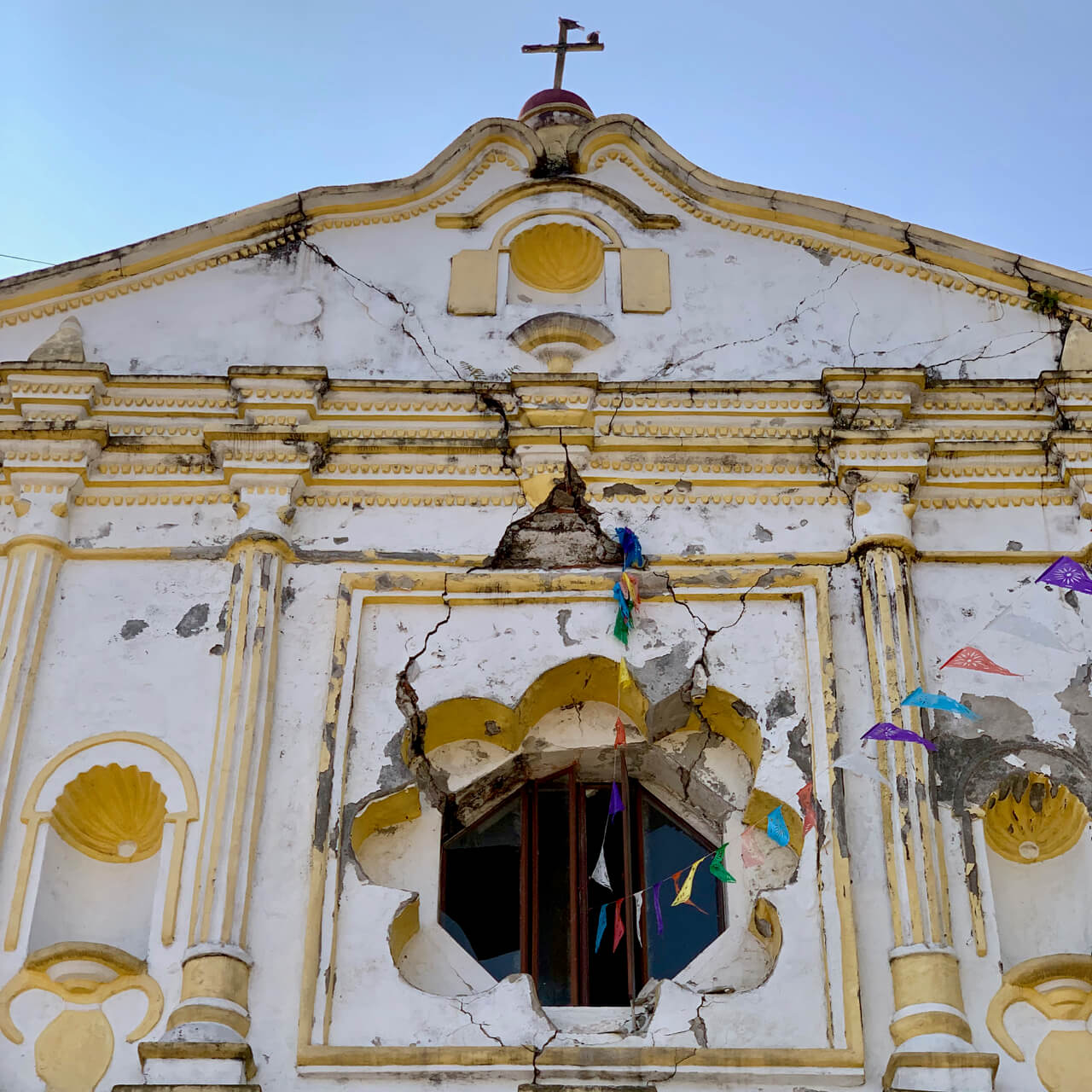
The earthquake-damaged church in San Cristóbal Lachirioag.
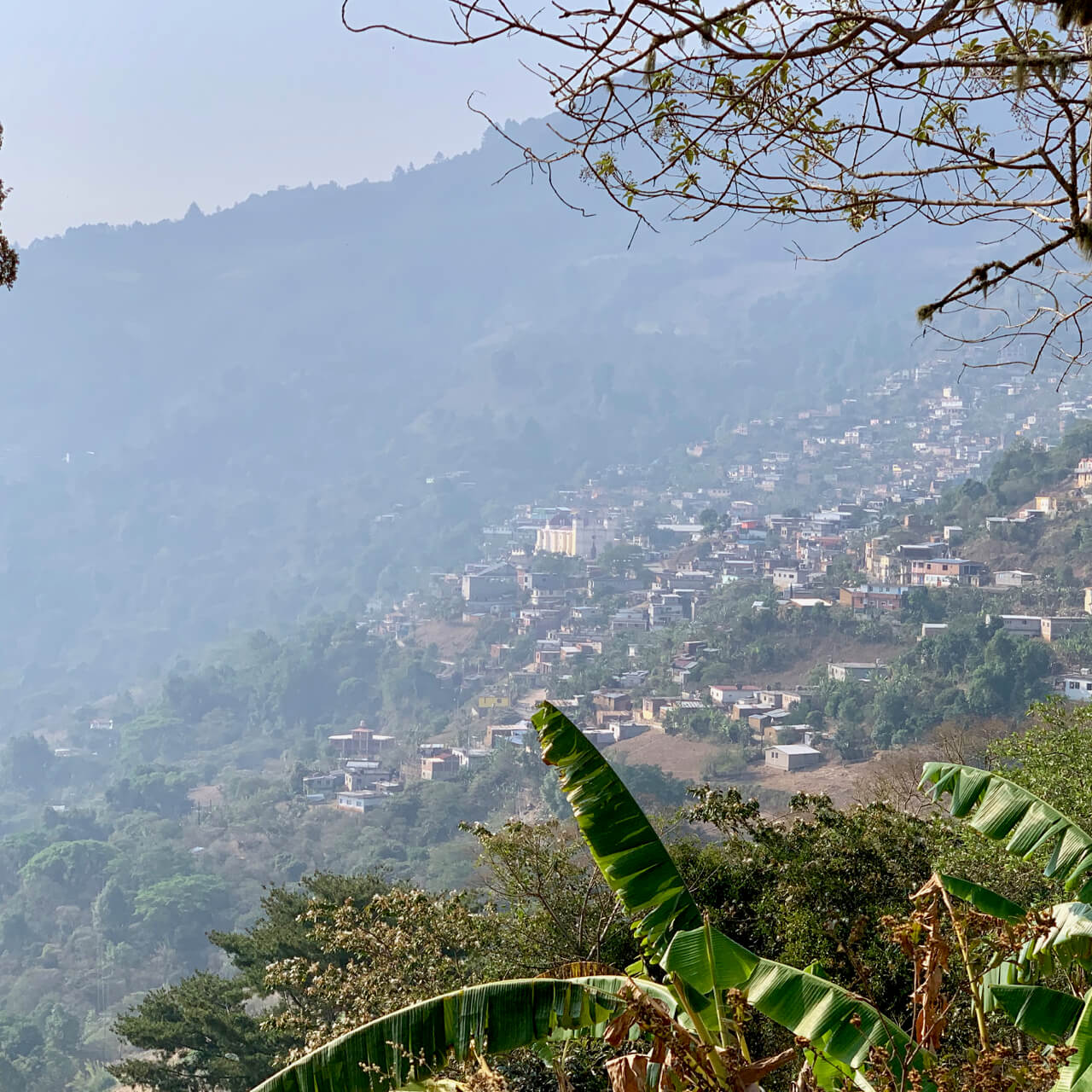
A view of San Cristóbal Lachirioag, Oaxaca, Mexico.
The Dia de la Santa Cruz festival was taking place on a hilltop above one of the schools. We carried bottles of water and began hiking. The sound of musical instruments grew louder as we walked. The trail was longer and steeper than we had estimated and some of us were moving slow. “This is like a penance,” said Elisandro smiling at us. He was right, we had to earn our lunch. After all, everyone in the village made the same trek. The top of the mountain was covered by trees. A school band played while people danced in costumes nearby. A loudspeaker rattled off announcements. I heard “Tosba” over the loudspeaker and mentioned it to Eli. They had announced the arrival of Edgar aka Tosba, he said. As we walked around, it was clear that they knew just about everyone. It was a tight-knit community, and we were fortunate to experience it for a day.
Mezcal Tosba is an extension of the community of San Cristóbal Lachirioag. Their years of being the “da ka bends” in town have paid off. The brand has partnered with Manos Indigenas Calidad Mexicana, an organization that provides economic support to promote the exercise of cultural rights, with the goal of strengthening indigenous communities identities. The CDI insignia is on all recent labels of Mezcal Tosba. Their importation company, Mezcal Tosba LLC, is based in San Jose, California. The bottle reflects the goals shared by the men in Zoochila in 2004. Their indigenous product is being sold in California (and elsewhere) and it provides jobs in Oaxaca. They even bottle Mezcal Tosba at the palenque which seems crazy given the rough terrain. It would be cheaper to do it in Oaxaca City, but they want to create work in San Cristóbal.
After finishing lunch, we walked down the hill in the heat of the sun. We stopped briefly to chat with a group on their way up. A man, speaking perfect English, said he had lived in the US for many years. His 80-year-old grandfather stood nearby. The elderly man had done the hike every year since he was a child. We were impressed but also thankful our penance was nearly done. At the base of the hill, we said our goodbyes to Edgar and hit the road with Elisandro.
We had a long drive back to Oaxaca City, but our journey wasn’t over yet. Elisandro took us to the small palenque of Jaime Morales in Yalalag. Jaime produces Espadin and Tobala mezcal and fruit brandies in small clay pots. He ferments in ceramic containers, partially buried in the ground. Every year he makes a small batch of mango brandy which is highly sought-after.
Our next stop was a polar opposite palenque. This large-scale palenque we visited had not officially opened. Eli chatted with one of the site managers, his relative. It was a holiday and the friendly crew on site offered us beer. The roof was the size of a football field. The tall stills had mechanical levers which allowed them to be easily opened and closed. The stainless steel fermentation vats were built into the ground with efficient drainage systems. It was a lot to take in after visiting Jaime.
A masterpiece in the making
Back in the car, we asked Eli about it, ready to join in on a rant about industrial mezcal. Instead, Elisandro said that he and Edgar offered to help that palenque get up and running. They saw an opportunity to make a lot of great mezcal. Once again, Eli’s attitude was impressive. We were there to visit Mezcal Tosba and he had taken us to two additional, very different, palenques. When we reached Oaxaca City, a Dia de la Santa Cruz parade was in full swing. We sat, stopped in traffic for about 20 minutes, before being dropped off at our Airbnb. It was an incredible two days to say the least. This might “sound cheesy”, like Edgar said of the film A Walk in the Clouds, but the Mezcal Tosba tale could be a movie of its own. Their story has entered the second act. Edgar is hitting his stride as a mezcalero and Elisandro is launching Dakabend in the US. Their initial triumphs will be met by challenges. And overcoming those trials will lead to their greatest achievements. We can’t wait to watch the rest of the movie. We will be cheering them on from the front row… while “snacking” on some of the world’s finest mezcal.
An interview with Mezcal Tosba Mezcalero, Edgar Gonzalez (YouTube)
Learn more about Mezcal Tosba:
- Journey to the Sierra Norte and Mezcal Tosba by Mezcalistas (2013)
- Oaxaca’s Mezcal Tosba Continues on Success Track by Alvin Starkman (2014)
- Can Homemade Liquor Jumpstart A Local Economy? on NPR / Planet Money (2014)


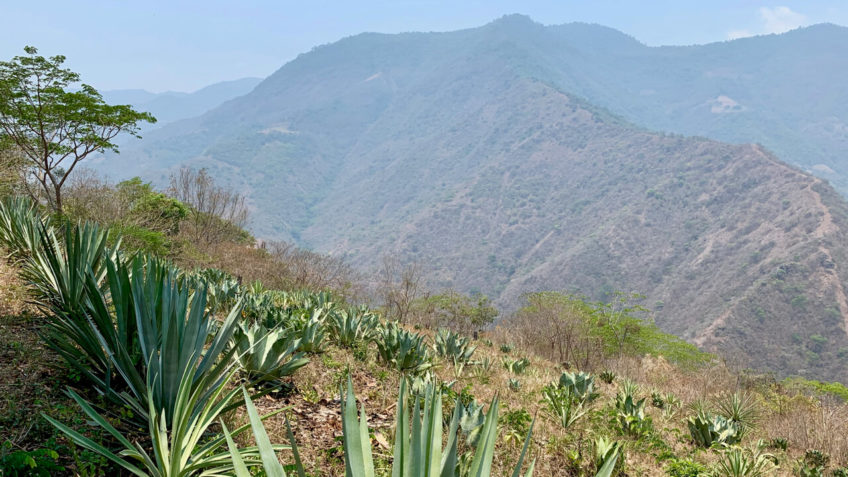
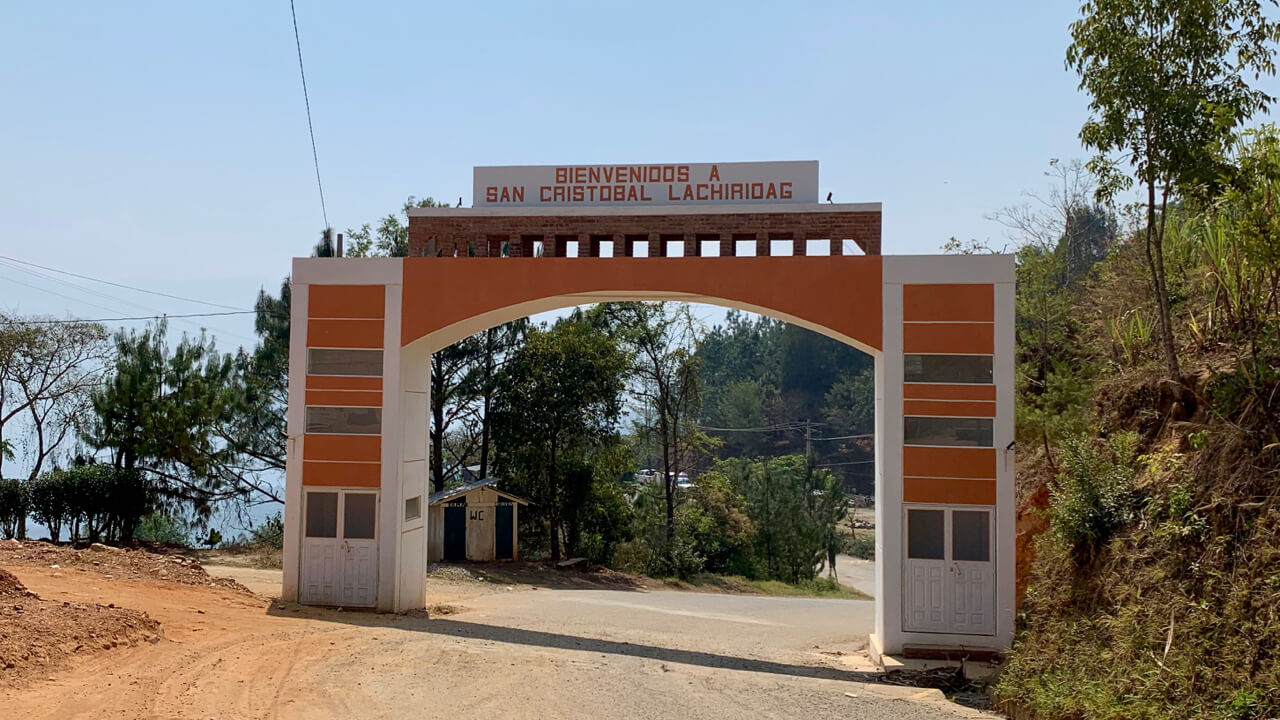
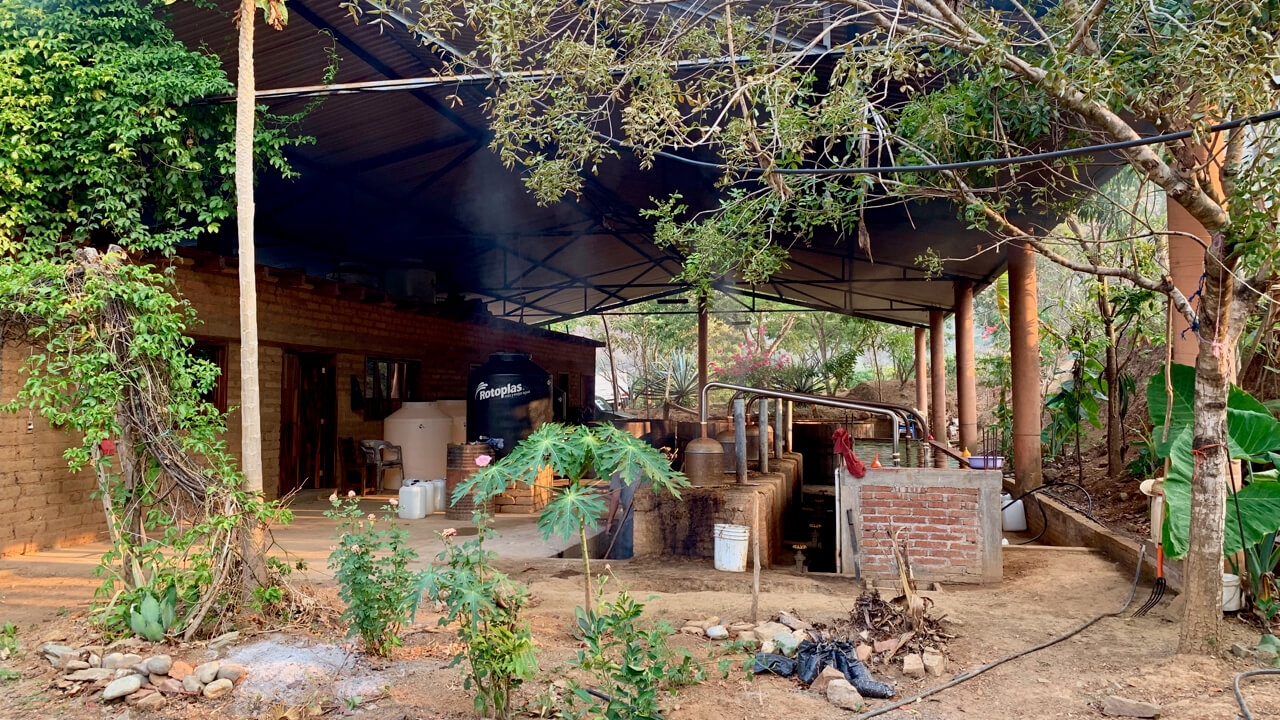
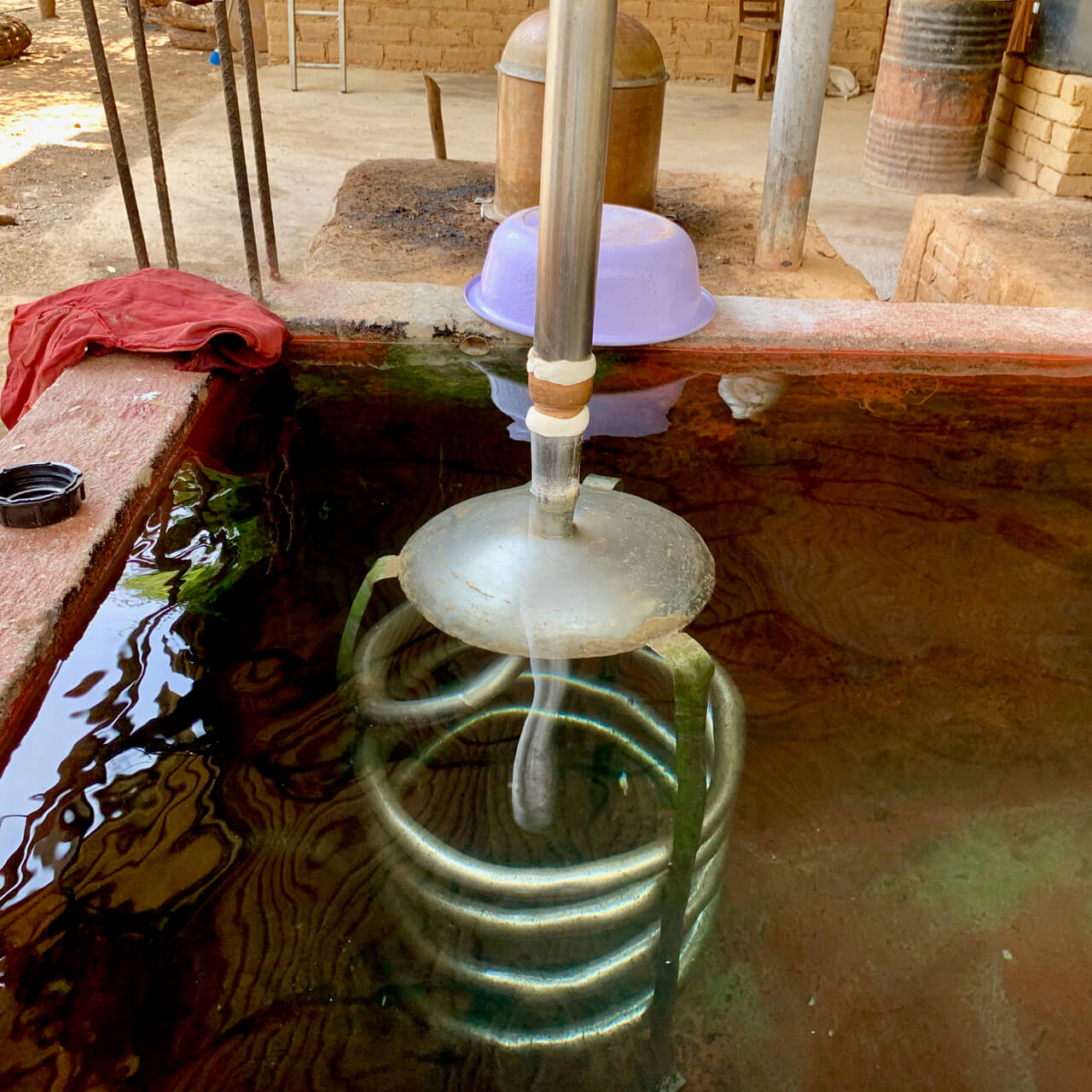
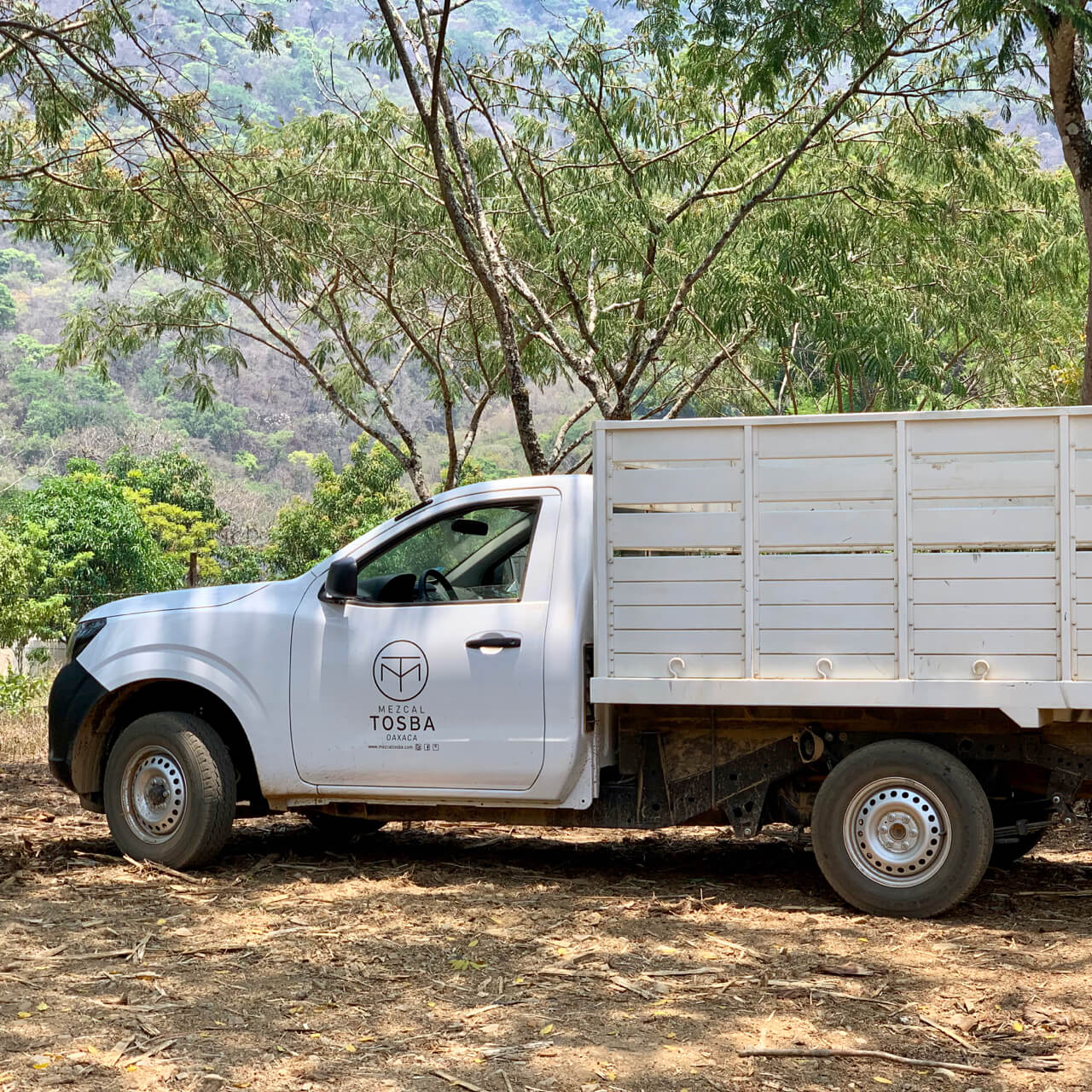
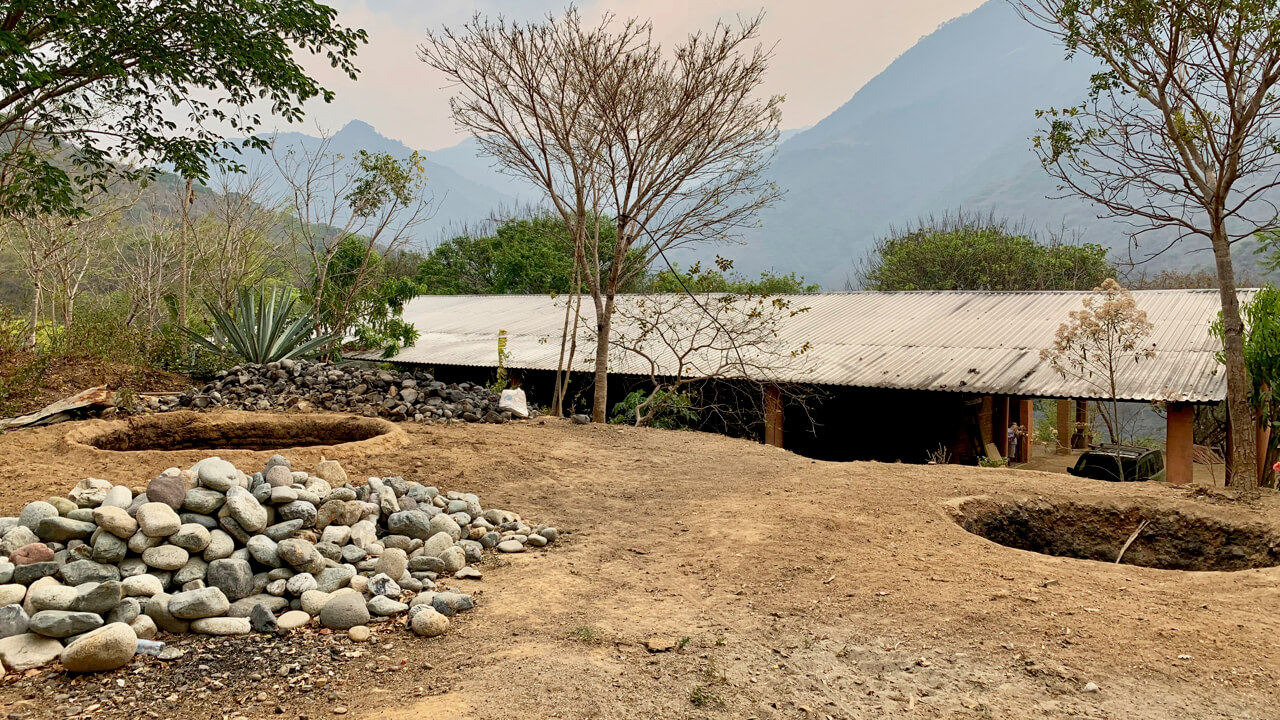
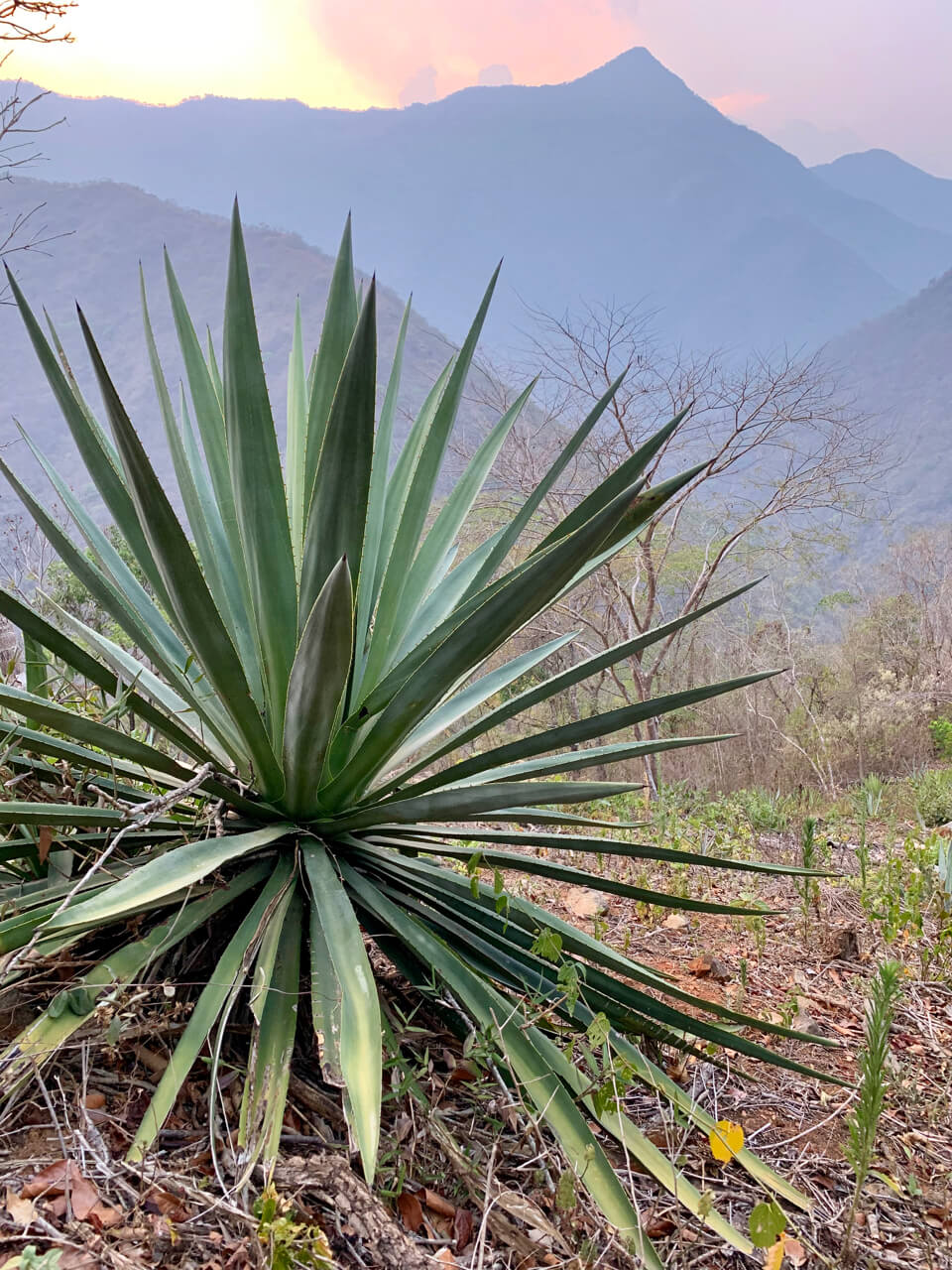

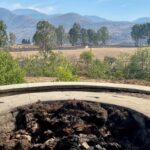
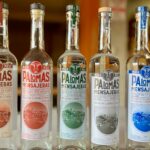
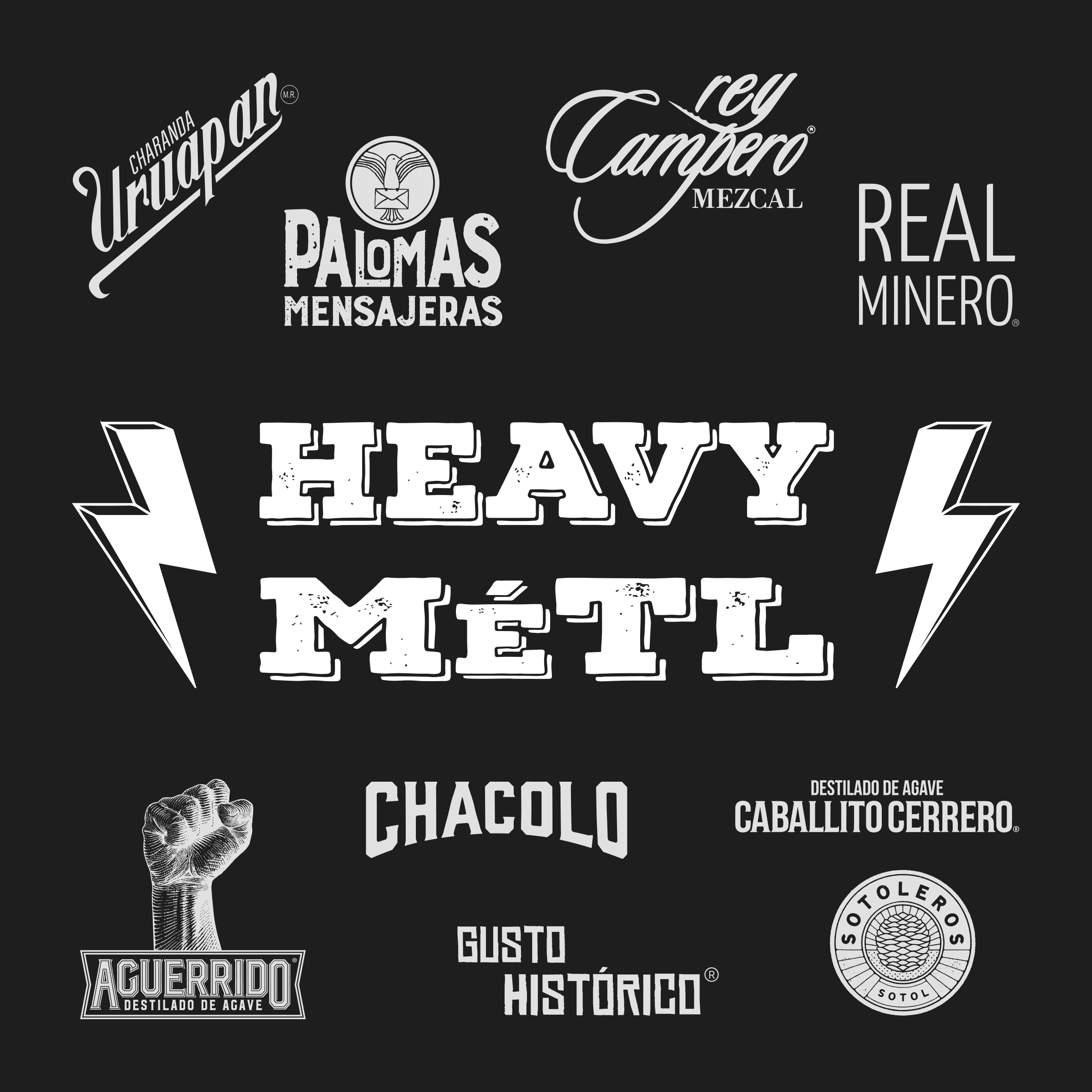
Mike Sosa
1 year agoExcelente articulo!! Gracias por compartir.
SoloAgave
3 years agoBeen trying to make a stop out here for 2 years – this article really has me thinking about my next trip to Oaxaca… Great writing – thanks for sharing!
Le Caignec Jean-Marie
5 years agoHello.
Congrats to this Family.
Just taste the Dakabend.
Amazing rhum.
Baido
5 years agoWhere can i buy their bottles in oax city?
Rorschach
5 years agoVery nice thank you!